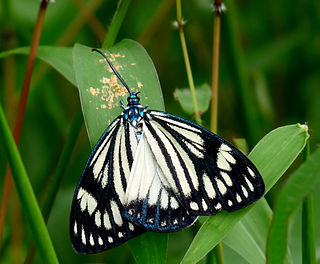
Rhododendron is a genus of 1,024 species of woody plants in the heath family (Ericaceae), either evergreen or deciduous, and found mainly in Asia, although it is also widespread throughout the highlands of the Appalachian Mountains of North America. It is the national flower of Nepal as well as the state flower of West Virginia and Washington. Most species have brightly coloured flowers which bloom from late winter through to early summer.

Hares and jackrabbits are leporids belonging to the genus Lepus. Hares are classified in the same family as rabbits. They are similar in size and form to rabbits and have similar herbivorous diets, but generally have longer ears and live solitarily or in pairs. Also unlike rabbits, their young are able to fend for themselves shortly after birth rather than emerging blind and helpless. Most are fast runners. Hare species are native to Africa, Eurasia, North America, and the Japanese archipelago.

Selaginella is the sole genus of vascular plants in the family Selaginellaceae, the spikemosses or lesser clubmosses.

In biology, a subgenus is a taxonomic rank directly below genus.

Leporidae is the family of rabbits and hares, containing over 60 species of extant mammals in all. The Latin word Leporidae means "those that resemble lepus" (hare). Together with the pikas, the Leporidae constitute the mammalian order Lagomorpha. Leporidae differ from pikas in that they have short, furry tails and elongated ears and hind legs.

Sorbus is a genus of about 100–200 species of trees and shrubs in the rose family, Rosaceae. Species of Sorbus (s.l.) are commonly known as whitebeam, rowan, service tree, and mountain-ash. The exact number of species is disputed depending on the circumscription of the genus, and also due to the number of apomictic microspecies, which some treat as distinct species, but others group in a smaller number of variable species. Recent treatments treat Sorbus in a narrower sense to include only the pinnate leaved species of subgenus Sorbus, raising several of the other subgenera to generic rank.

In zoological nomenclature, a type species is the species name with which the name of a genus or subgenus is considered to be permanently taxonomically associated, i.e., the species that contains the biological type specimen(s). A similar concept is used for suprageneric groups called a type genus.

Microtus is a genus of voles found in North America, Europe, and northern Asia. The genus name refers to the small ears of these animals. About 62 species are placed in the genus. They are stout rodents with short ears, legs, and tails. They eat green vegetation such as grasses and sedges in summer, and grains, seeds, roots, and bark at other times. The genus is also called "meadow voles".

The Plasmodiidae are a family of apicomplexan parasites, including the type genus Plasmodium, which is responsible for malaria. This family was erected in 1903 by Mesnil and is one of the four families in the order Haemospororida.

The Haemosporida are an order of intraerythrocytic parasitic alveolates.

Rousettus is a genus of Old World fruit bats or megabats. They are sometimes referred to as dog-faced fruit bats, or flying foxes. The genus is a member of the suborder Megachiroptera. The genus consists of ten species that range over most of Africa to southeast Asia, and the islands of the south Pacific. They are noteworthy for being the only megabats capable of echolocation.

Neritidae, common name the nerites, is a taxonomic family of small- to medium-sized saltwater and freshwater snails which have a gill and a distinctive operculum.

The Spilosomina are a subtribe of tiger moths in the Arctiini tribe, which is part of the family Erebidae.

Arvicolini is a tribe of voles in the subfamily Arvicolinae.

Procridinae is a subfamily of the family Zygaenidae.

Glenea is a genus of longhorn beetles belonging to the family Cerambycidae, subfamily Lamiinae.

Phytoecia is a genus of longhorn beetles of the subfamily Lamiinae, containing the following species:



















